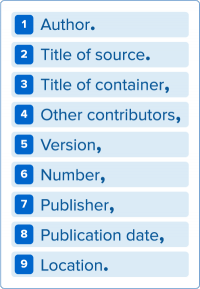Assignment 1.3: Giving Credit
| Site: | Cowichan Valley School District - Moodle |
| Course: | English 11, CVOLC, Online, 21-22 |
| Book: | Assignment 1.3: Giving Credit |
| Printed by: | Guest user |
| Date: | Tuesday, 16 December 2025, 12:46 PM |
1. Learning Targets
|
Learning Target(s):
|
2. Giving Credit
"Always give credit where credit is due. If the words that you are including in your work belong to someone else, give credit.
Here is a brief list of what needs to be credited or documented:
- Words or ideas presented in a magazine, book, newspaper, song, TV program, movie, website, computer program, letter, advertisement, or any other medium
- Information you gain through interviewing or conversing with another person, face to face, over the phone, or in writing
- When you copy the exact words or a unique phrase
- When you reprint any diagrams, illustrations, charts, pictures, or other visual materials
- When you reuse or repost any digital media, including images, audio, video, or other media
There are certain things that do not need documentation or credit, including:
- Writing your own lived experiences, your own observations and insights, your own thoughts, and your own conclusions about a subject
- When you are writing up your own results obtained through lab or field experiments
- When you use your own artwork, digital photographs, video, audio, etc.
- When you are using "common knowledge," things like folklore, common sense observations, myths, urban legends, and historical events (but not historical documents)
- When you are using generally accepted facts (e.g., pollution is bad for the environment) including facts that are accepted within particular discourse communities (e.g., in the field of composition studies, "writing is a process" is a generally accepted fact). "
Source: OWL: Online Writing Lab
3. Citing Your Work
English language arts traditionally use the Modern Language Association (MLA) format for writing citations and lists of works cited. The MLA format, when compared to others, is relatively simple to learn. Although, there are a few key details that must be remembered. It is important for writers to know that each type of resource (for example, a novel, an article, a Youtube video, or a website) has its own set of specific requirements when being cited. Therefore, it is vital to pause and carefully check that each citation is done correctly. The Owl Purdue website, created by Purdue University, has become the standard hub of information for these details.
You can access the Owl Purdue website HERE. You'll see a list of different types of sources on the left. Use this to navigate around and find the instructions for your specific type of source. Keep in mind that this website is created by an educational institution and is just one of many available sources. However, the Purdue style-guides are known for their accuracy and reliability. Using online citation generators such as bibme.org and easybib.com and citationmachine.net can sometimes be effective.
Properly citing your sources in MLA format is comprised of two parts: In-Text Citations and a Works Cited Page. The in-text citations are found as stated, within the text itself; while the works cited page is a more detailed list of all the sources used and is found at the end of the document.
4. In-Text Citations
An in-text citation is a brief reference in your text that indicates the source you cited. It should direct readers to the entry in your works cited list for that source.
You can see examples at the following website from bibliography.com.
Example of In-text Citation in MLA Format
As well, Owl Purdue has produced a set of videos to help writers quickly understand the most common citation-related situations
In this video, you’ll learn how to use in-text citations in your writing.
5. Works Cited
The second part of citing your sources is providing a Works Cited page at the end of your document. This information will help the reader, should they want to look up or read the cited information for themselves. The MLA style guide at OWL Purdue has information about almost every type of source you might come across.
In general you will find the following information for each resource in the works cited list:

After watching the video, please review the handouts and links below to further understand how to create a works cited page:
- OWL Purdue Works Cited Information Page
- Example of a Works Cited Page
- Example of complete paper with marginal notes explaining proper MLA format.
- MLA Citation Generator: A citation generator is an easy tool that helps you cite sources in a specific citation style.
You fill in the forms with information about a source, such as the author(s), title, and publication date. The tool then creates an accurate reference and in-text citation that you can use to give credit to the original author.
6. ASSIGNMENT 1.3
Go to "1.3 Giving Credit" Assignment on the main page of the course to complete this section.